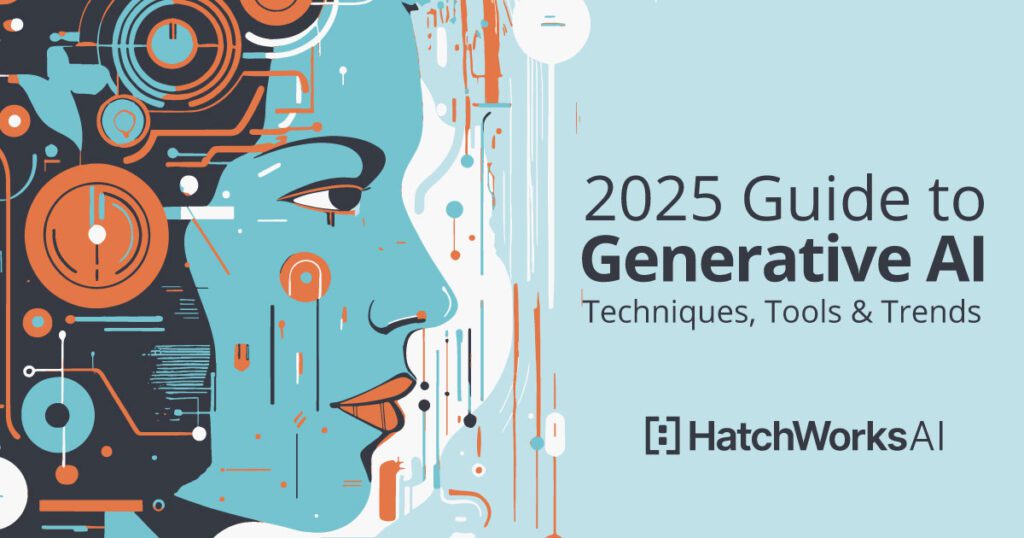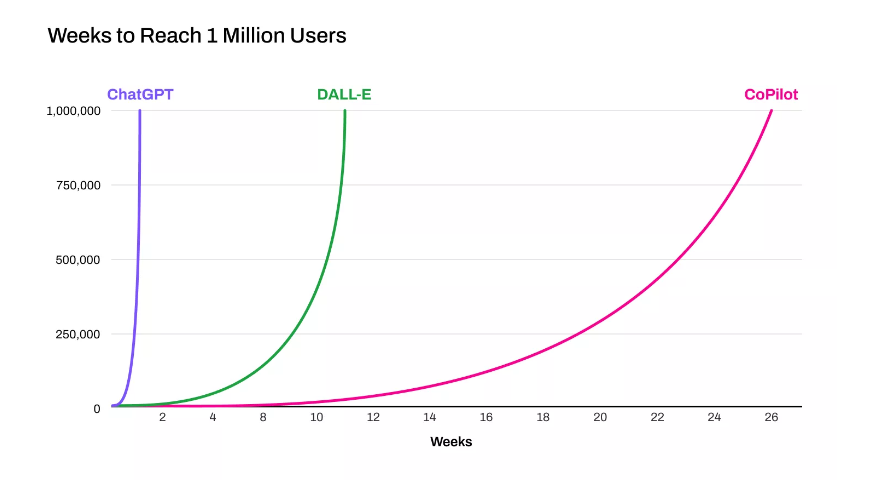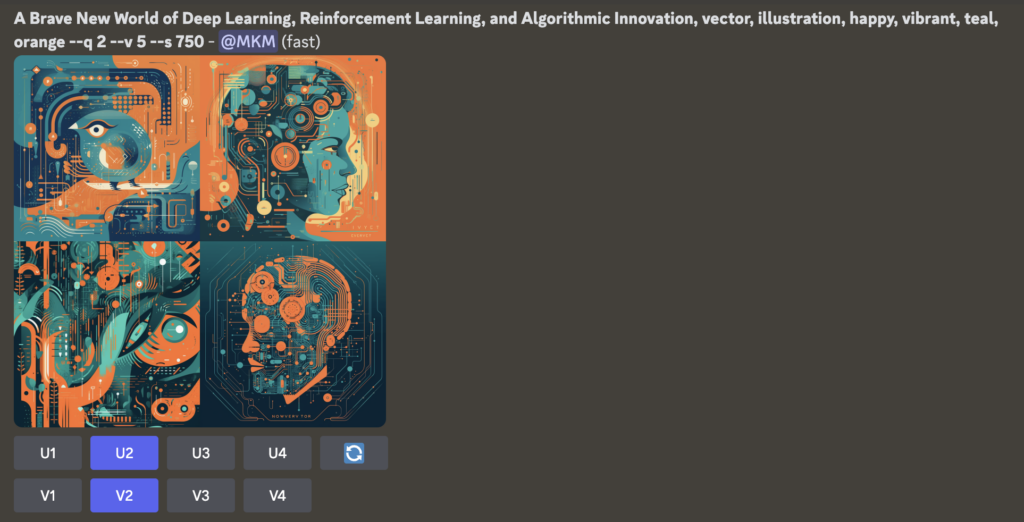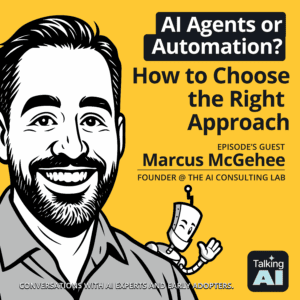Major tech companies like Microsoft, Google, Coca-Cola, and Spotify are championing AI, integrating it into various aspects of their businesses, from content generation to product innovation.
This groundbreaking technology is reshaping traditional workflows, enabling unprecedented levels of innovation and efficiency across a diverse range of sectors.

In this guide, we’ll introduce you to the burgeoning world of generative AI applications. We’ll explore its capabilities, dive into its many use cases, and share tips on making it a seamless part of your projects.
Plus, we’ll tackle the ethical and security challenges that come with this groundbreaking technology and provide insights on responsible AI deployment.
Gen AI is transforming industries and redefining how we create and build products, as evidenced by the projected growth of the AI market to an astounding $110.8 billion by 2030.
At HatchWorks AI, we embrace new technologies to deliver top-notch AI-Powered Software Development services. That’s why we’re harnessing generative artificial intelligence and retrieval augmented generation to build digital products that surpass customer expectations and redefine the future of digital product development.
Are ready to unlock the potential of generative AI? Let’s dive in!
Exploring large language models and generative AI algorithms
Artificial intelligence and machine learning models have come a long way, with advances in deep learning propelling generative AI adoption at unprecedented rates. For example, ChatGPT, an OpenAI language marvel, impressively hit 1 million users in just 5 days, while its sibling, DALL-E, which generates images, reached the same milestone in a mere 2.5 months.
In comparison, other innovative products outside the AI category took significantly longer to gain traction. Facebook, for instance, reached 1 million users in 10 months, and it took Netflix 3.5 years to achieve the same milestone.

At its core, gen AI is powered by deep learning algorithms that analyze vast amounts of data to make predictions, generate content, and even create new data.
Let’s dive into some of the most influential algorithms and see how they’re shaping the future of digital innovation.
Deep learning
One of the most striking examples of deep learning’s influence on gen AI is natural language text generation. By processing and understanding the structure, syntax, and semantics of human language, these advanced algorithms generate coherent, contextually appropriate, and sometimes creative text that seems to have been written by a human.

Take ChatGPT, for instance. This large language model is a prime illustration of deep learning’s potential in crafting human-like text. Its rapid adoption showcases the incredible demand for AI tools that can seamlessly interact, and communicate with an increasingly human-like touch, revolutionizing the way we work, learn, and connect with one another.
Moreover, ChatGPT is transforming our relationship with search engines, as it fosters more declarative and conversational interactions, making the process of seeking information more intuitive, efficient, and engaging.
OpenAI‘s GPT-4 has made remarkable improvements over its predecessor, GPT-3.5, boasting higher scores on nearly every academic and professional exam, even surpassing 90% of lawyers on the bar exam. Additionally, GPT-4 can now accept images as inputs, expanding its potential applications.
Another example is the recent formation of Google DeepMind, a powerhouse union joining forces to responsibly accelerate AI development. This dynamic partnership is set to conquer the toughest scientific and engineering obstacles while paving the way for AI to revolutionize industries and propel science forward.
Reinforcement learning
Taking a step further, reinforcement learning brings another dimension to generative AI. This approach involves training algorithms through trial and error, allowing them to learn from their mistakes and improve their performance over time.
Reinforcement learning has found numerous applications in generative AI across various industries, unlocking innovative possibilities and transforming how we approach problems.
- In autonomous driving, systems like AWS DeepRacer leverage reinforcement learning to optimize navigation and decision-making.
- In trading and finance, IBM’s system uses reinforcement learning to make intelligent financial trades.
- In healthcare, reinforcement learning is employed for efficient patient record management, research, and diagnostic assistance. These powerful applications demonstrate the adaptability and potential of reinforcement learning in generative AI.
These models have seen so much data… that by the time that they're applied to small tasks, they can drastically outperform a model that was only trained on just a few data points."
Kate Soule, Sr Manager, Exploratory AI Business Strategy, IBM
The AI toolbox
When it comes to selecting the right algorithm for a specific use case, it’s essential to consider the strengths and weaknesses of various AI tools.
Some popular generative AI algorithms include Generative Adversarial Networks (GANs), Variational Autoencoders (VAEs), and Transformer models like GPT-4.
- GANs excel at generating realistic images and can be used for tasks like image-to-image translation and generating artwork.
- VAEs, on the other hand, are particularly well-suited for data compression and can be applied in areas like anomaly detection and image denoising.
- Transformer models have been a game-changer for natural language processing, powering state-of-the-art text generation, translation, and summarization systems.
Armed with the knowledge of these algorithms, you’re ready to explore their creative applications and unleash their potential.
Unleashing creativity with generative AI models
All across various domains, generative AI models are sparking a creative revolution.
Music and speech generation
While it’s unlikely to replace human creativity entirely, generative AI is making waves in the music composition world. It serves as a powerful tool for enhancing the creative process. By generating unique melodies, harmonies, and rhythms that adhere to given text descriptions, AI models like MusicLM inspire musicians to explore new ideas and push the boundaries of their art.
Take, for example, the recent news of a trending song called “Heart on My Sleeve,” written and produced by TikTok user ghostwriter977. The vocals for the song were generated by artificial intelligence and made to sound like Canadian musicians Drake and The Weeknd.
Despite its growing popularity, Universal Music Group (UMG) requested the removal of the song from various music platforms and called for a block on AI using copyrighted songs for training purposes. This incident highlights the ongoing debate surrounding the ethical and legal implications of AI-generated content in creative industries.
Text generation
Large language models like GPT and BERT are revolutionizing content creation and automation. With the power of Natural Language Processing (NLP) techniques, AI models can generate coherent and contextually relevant text for a wide range of applications.
Text prompts can be used as inputs to guide AI-generated text, ensuring the output aligns with desired context and themes. This technology is not only automating content creation but also helping writers overcome writer’s block and enrich their writing.
These models can even be prompted to generate code. AI-generated code and templates are streamlining the development process for companies, allowing them to more rapidly prototype and build high-quality software solutions for their clients.

One notable example is GitHub Copilot, an AI-powered code assistant developed by GitHub and OpenAI. It integrates with popular integrated development environments (IDEs) like Visual Studio Code, Neovim, and JetBrains, offering auto-completion of code in languages such as Python, JavaScript, TypeScript, Ruby, and Go.
By leveraging the capabilities of OpenAI Codex, GitHub Copilot makes it easier for developers to navigate unfamiliar coding frameworks and languages while reducing the time spent reading documentation. Furthermore, a research study conducted by the GitHub Next team revealed that GitHub Copilot significantly impacts developers’ productivity and happiness. Surveying over 2,000 developers, the study found that between 60-75% of users feel more fulfilled, less frustrated, and are able to focus on more satisfying work.
Image generation

AI-generated art is transforming the creative and design industry by enabling artists and designers to create unique visuals using image generators. From photorealistic images generated using GANs to medical images for research and diagnostic purposes, generative AI is revolutionizing the world of visual content.
According to Everypixel, “More than 15 billion images were created using text-to-image algorithms since last year. To put this in perspective, it took photographers 150 years, from the first photograph taken in 1826 until 1975, to reach the 15 billion mark.” This staggering statistic underscores the transformative power and rapid evolution of AI in the realm of image generation.
At HatchWorks AI, we’re all about diving into the exciting world of Generative AI, and we wanted our blog to really capture that energy. So our Senior Marketing Designer, Luis Leiva, opted for image generation to whip up a unique banner image for our blog post.
We fed the Midjourney AI model this prompt: “A Brave New World of Deep Learning, Reinforcement Learning, and Algorithmic Innovation, vector, illustration, happy, vibrant, teal, orange.”

Using Generative AI isn’t just about number-crunching and problem-solving; it’s also about unleashing creative flair. We hope to inspire you to ponder the broader applications of generative AI and explore the endless possibilities it offers in both practical and artistic realms.
Some more groundbreaking applications of image generation include:
Personalized marketing
Generative AI can create tailored visuals for marketing campaigns. Platforms such as Jasper, enable teams to generate personalized and brand-specific content at a much faster pace, leading to a tenfold increase in productivity. By leveraging AI-powered tools, businesses can craft captivating social media posts, advertisements, and marketing copy, considerably boosting the efficacy of their marketing strategies while maintaining a more targeted approach.
Icon and Logo Design
Having unique and tailored branding elements, such as icons and logos, is essential for products to stand out. AI-generated icons and logos offer an innovative solution to this challenge.
Transforming the world of icon and logo design, numerous new tools utilize AI-driven innovation to elevate the creative process. Magician for Figma uses AI to generate unique icons from text inputs, streamlining the icon creation process. Adobe Firefly focuses on providing creators with an infinite range of generative AI models for content creation.
By utilizing these cutting-edge tools, designers can effortlessly generate custom vectors, brushes, textures, and branding elements, leading to more distinctive and memorable designs.
Data Visualization and Analysis
AI-generated charts, graphs, and other visual representations of complex data sets enable companies to present information in a clear, engaging, and insightful manner, enhancing their product’s user experience.
Tools like Ask Viable could play a crucial role in this process, offering AI-powered analysis that turns unstructured qualitative data and feedback into actionable insights, allowing businesses to make data-driven decisions and optimize their performance.
User Interface Design
AI-generated interface mockups and dynamic design elements are revolutionizing the way companies create intuitive and visually appealing user experiences for their applications.
AI-generated interface mockups and dynamic design elements are revolutionizing the way companies create intuitive and visually appealing user experiences for their applications.
Tools like Genius are at the cutting edge of this transformation, offering an AI design companion in Figma that understands what you’re designing and makes suggestions using components from your design system. These AI-driven solutions allow designers to explore a multitude of ideas, iterate more efficiently, and ultimately deliver more engaging user interfaces.
Tips for integrating generative AI into your projects
To make generative AI work for you and your projects, it’s crucial to understand the best practices for selecting, training, and implementing AI algorithms. Here are some valuable tips to help you navigate the integration process and maximize the benefits of generative AI.
Selecting the Right Algorithm
- Identify your project goals: Clearly outline the objectives of your project and the desired outcomes before choosing a generative AI algorithm. This will help you determine which algorithm best aligns with your goals.
- Consider your data: Assess the type and amount of data you have available. Certain algorithms may require large datasets, while others can work effectively with smaller amounts of data.
- Evaluate algorithm performance: Research the performance of various generative AI algorithms and compare their success in generating high-quality, relevant content. Select the one that best meets your quality and creativity requirements.
Incorporating generative AI into your workflows
- Prepare your data: Ensure that your data is clean, well-structured, and diverse to provide a solid foundation for training your generative AI model.
- Seamless integration: Design your workflows to accommodate generative AI output, making it easy to incorporate generated content into your projects.
- Human-AI collaboration: Emphasize the importance of human-AI collaboration, using AI as a tool to enhance creativity and productivity rather than replace human input.
- Iterate and refine: Continuously test and refine your generative AI implementations, gathering feedback from users and stakeholders to improve the overall quality and effectiveness of AI-generated content.
Assessing AI output quality and effectiveness
- Establish quality metrics: Define clear metrics to measure the quality and effectiveness of your generative AI output. This can include factors such as coherence, relevance, and creativity.
- Regular evaluation: Periodically evaluate the performance of your generative AI models against your established quality metrics and make improvements as needed.
- Seek user feedback: Gather feedback from end-users and other stakeholders to understand how well your generative AI output meets their needs and expectations. Use this feedback to refine your AI models and workflows further.
By following these tips, you can successfully integrate generative AI into your projects and make the most of this powerful technology.
📌 For an in-depth exploration of how generative AI is revolutionizing various sectors, read our comprehensive report on Generative AI Use Cases Across Industries.
To see how HatchWorks is leading the way in AI-powered software development – visit our Generative-Driven Development™ page now.
Navigating the ethical and security challenges of generative AI
Generative AI, like any powerful technology, brings a set of ethical and security challenges that must be addressed proactively to ensure responsible deployment. Here, we’ll provide guidance on how to navigate these challenges effectively and maximize the positive impact of generative AI.
First, address the potential misuse of generative AI by developing and enforcing strict guidelines for its ethical use within your organization. Encourage a culture of accountability and monitor generative AI usage in your projects to prevent misuse.
Secondly, mitigate the risks of biased or uncontrolled AI-generated content by training AI models on diverse and representative datasets. Be aware that earlier models like GPT-3 have demonstrated biases related to gender, race, and religion, which can influence the output. Implement mechanisms to detect and mitigate harmful or offensive content and educate your team and end-users about potential biases and limitations, promoting responsible usage and critical evaluation.
Protection against the malicious use of generative AI is essential. Implement robust security measures, monitor AI-generated content for signs of malicious activity, and collaborate with industry partners and stakeholders to develop and promote best practices for mitigating malicious use.
In addition to security measures, prioritize transparency in your generative AI deployments. Openly communicate the use of AI-generated content and the methodologies behind it. Stay informed about the latest ethical and security developments in the generative AI field and adapt your strategies and practices accordingly. Foster a strong culture of responsibility and ethical awareness within your organization.
Lastly, invest in education and training. Provide your team members with education on generative AI technology, its potential risks, and ethical considerations, fostering a culture of informed responsibility. Encourage continuous learning to stay updated on the latest advances in generative AI and its ethical and security implications. Contribute to public awareness and understanding of generative AI, promoting informed decision-making and responsible use.
It’s predicted that AI could impact 300 million full-time jobs worldwide, so it is crucial to emphasize responsible and ethical use. By proactively addressing these challenges, you can ensure the responsible and beneficial use of generative AI in your projects, leading to a more innovative, efficient, and ethical digital product development process.
Frequently Asked Questions about generative AI
Generative AI is a form of artificial intelligence that uses algorithms to create new data, content, or predictions based on existing data. Unlike discriminative AI, which focuses on classifying and predicting outcomes, generative AI generates new instances, such as images, text, or music, based on learned patterns and structures.
Generative AI is a subfield of machine learning, which is an overarching discipline that deals with teaching computers to learn and make decisions based on data. Generative AI specifically focuses on the creation of new content by learning from existing data.
A Generative Adversarial Network (GAN) is a type of generative AI model that consists of two neural networks, a generator and a discriminator, that work together in a competitive manner. The generator creates new content, while the discriminator evaluates the content’s quality and authenticity.
Generative AI can explore a vast range of design possibilities, optimize solutions, and help designers create innovative, functional, and aesthetically appealing products.
Discover how our Generative-Driven Development services can transform your business by visiting https://hatchworks.com/generative-driven-development/.
Businesses can use generative AI to automate content generation, optimize decision-making, and create personalized experiences for customers, ultimately improving efficiency and reducing costs.
Some limitations of generative AI include the need for large amounts of training data, high computational resources, potential bias in generated content, and difficulty in controlling the generated output. Additionally, generative AI models may struggle to understand and generate content that falls outside the scope of their training data.
No. While generative AI can produce impressive results, it is not a replacement for human creativity. AI-generated content is based on patterns learned from existing data, meaning it cannot replicate the full range of human emotions, experiences, or intuition that drive creativity.
Summary
Generative AI has immense potential to revolutionize how we create, design, and innovate in the digital realm. By harnessing the power of AI tools and technologies, we can unlock new creative possibilities and enhance the quality and efficiency of our projects. By emphasizing responsible and ethical use, we can ensure that generative AI continues to have a positive impact on the industry and contributes to a more vibrant and creative digital landscape.
Generative AI has immense potential to revolutionize how we create, design, and innovate in the digital realm. By harnessing the power of AI tools and technologies, we can unlock new creative possibilities and enhance the quality and efficiency of our projects.
Balancing ethical concerns with responsible use, we can ensure that generative AI contributes to a more vibrant and creative digital landscape while mitigating its potential negative impact on the job market.
At HatchWorks AI, we understand the importance of leveraging generative AI responsibly and ethically. As a software development partner, we utilize the power of generative AI to build innovative digital products that meet the unique needs and expectations of our clients. Reach out to us to learn more about how we can help you harness the potential of generative AI for your projects.
Essential AI Skills for Your Team
AI Training for Teams gives your team foundational AI knowledge, preparing you to effectively integrate AI into your business.




